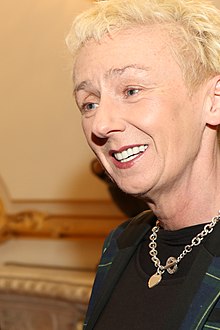|
Muriel Gray
Muriel Janet Gray FRSE (born 30 August 1958) is a Scottish author, broadcaster and journalist. She came to public notice as an interviewer on Channel 4's alternative pop-show The Tube, and then appeared as a regular presenter on BBC radio. Gray has written for Time Out, the Sunday Herald and The Guardian, among other publications, as well as publishing successful horror novels. She was the first woman to be Rector of the University of Edinburgh and is the first female chair of the board of governors at Glasgow School of Art. Personal lifeBorn in East Kilbride, Gray is of partly Jewish ancestry. She presented a documentary for Channel 4 tracing her Jewish roots on her mother's side, entitled The Wondering Jew (1996), in which she discovered her maternal line descended from what is now Moldova.[1] She is married to television producer Hamish Barbour and they have three children.[2] In 1997, their daughter nearly drowned in a garden pond, which left her permanently brain damaged.[3] CareerEarly careerA graduate of the Glasgow School of Art, she worked as a professional illustrator and then as assistant head of design in the National Museum of Antiquities in Edinburgh.[4] Broadcasting careerAfter playing in punk band The Family Von Trapp, she became an interviewer on the early Channel 4 alternative pop show The Tube from 1982; she was the main anchor on the short-lived ITV Border show Bliss[5] in 1985, she presented Frocks on the Box (1987–88) and The Media Show (1987–89) again for Channel 4.[6] She was briefly a DJ for Edinburgh's Radio Forth in 1983 and 1984. She was a regular stand-in presenter on BBC Radio 1 during most of the eighties, including for John Peel. She also presented regularly on BBC Radio 4, for Start the Week in Russell Harty's absence and also during Jeremy Paxman's leave. Later she presented The Munro Show (which documented her climbing Scotland's highest hills, the Munros). She accompanied this with the book The First Fifty – Munro Bagging Without A Beard. She presented various other TV shows including Ride On, a motoring magazine show for Channel 4, The Design Awards, for BBC, and The Booker Prize awards for Channel 4. Gray presented Art Is Dead – Long Live TV. This programme sparked a controversy when it was discovered that the series, covering the work of five artists, was a spoof.[7] Gray presented the definitive documentary on The Glasgow Boys, a group of influential 19th-century painters, including Sir John Lavery and James Guthrie, who challenged the orthodox values of their day. The Glasgow Boys was shown on BBC2. Gray co-presented Channel 4's coverage of the 2016 Turner Prize ceremony in Glasgow.[8] WritingGray has been a columnist for many publications, including Time Out magazine, the Sunday Correspondent, the Sunday Mirror, and Bliss magazine, and now writes a regular column in the Sunday Herald. She won Columnist of the Year in the 2001 Scottish press awards. She writes regularly for The Guardian. She became a best-selling horror novelist with the publication of her first novel The Trickster (1995), which was followed by two more, Furnace and The Ancient. Stephen King described The Ancient as "Scary and unputdownable." In 2004 a collection of short stories, "Scottish Girls About Town: And sixteen other Scottish women authors" was published. Gray was chosen with Jenny Colgan and Isla Dewar to feature on the cover.[9] She wrote a history of Glasgow's Kelvingrove Art Gallery and Museum to mark its re-opening in 2006. She appears on the BBC Two programme Grumpy Old Women. In 2014 she contributed a new piece of writing for the 21 Revolutions project which had been inspired by the collection held in the Glasgow Women's Library.[10] Business interestsShe started her own production company in 1989, originally named Gallus Besom (besom being a Scots or Northern English term of contempt for a surly or purposely awkward woman[11][12][13] and gallus bold or cheeky[13] in Scots),[14] then renamed to Ideal World in 1993.[15] It merged in 2004 with Wark Clements, the company co-owned by Kirsty Wark and her husband Alan Clements, to form IWC Media. The partners then sold the new company in 2005 to media company RDF Media for an estimated £12 million. Honours and appointments
Charity workIn 2005, she became Patron of the Scottish charity Trees for Life which is working to restore the Caledonian Forest. She is also a patron of the Craighalbert Centre, a conductive education school in Cumbernauld near Glasgow. She currently serves as a trustee on the following boards: the Glasgow Science Centre, the Scottish Maritime Museum, The Lighthouse and the Children's Parliament. She supports Action Earth.[24] In January 2009 she became the first patron of Scotland's Additional Support Needs Mediation Forum, RESOLVE:ASL. WritingFiction
Non fiction
References
External links |
||||||||||||||
Portal di Ensiklopedia Dunia
